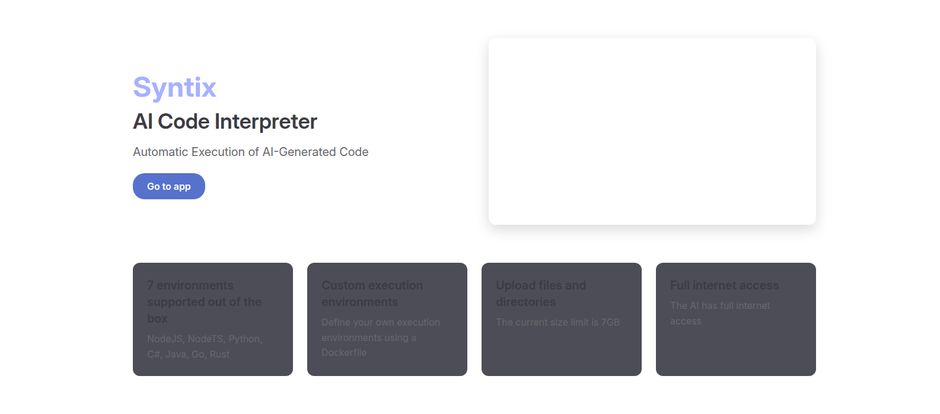Look, we’ve all been there. You’re wrestling with a gnarly bit of code, you turn to an AI assistant for help, and it spits out a beautiful, confident, and... completely broken block of code. It’s the digital equivalent of a person giving you directions to a place they’ve never actually been. AI hallucinations are a real pain, and honestly, they've made me pretty skeptical about the whole AI-assisted coding craze.
So when I heard about a tool called Syntix, I was intrigued but cautious. The pitch? An “AI Code Interpreter” that doesn’t just write code, it runs it. In a dedicated environment. With internet access. It’s a bold claim, promising to bridge the gap between theoretical code and practical application. It's like finding a cookbook that also comes with a fully stocked kitchen and a chef to test the recipes for you.
As someone who’s been neck-deep in SEO, tech trends, and traffic generation for years, I've seen countless tools promise to revolutionize our workflow. Most of them are just a flash in the pan. But this one... this one felt a little different. So, I decided to put on my old developer hat and see if Syntix could live up to the hype.
So, What Exactly is Syntix?
Let's get this straight. Syntix isn't just another chatbot that’s read the entire internet and can mimic programming syntax. It's fundamentally an interpreter. You ask it a programming question, and it generates code to answer it. But here’s the magic trick: it then immediately executes that code in a secure, sandboxed environment and shows you the output. Instantly.
This simple-sounding step is a massive leap. It means the AI gets immediate feedback on its own work. If it writes code that throws an error, it knows. If it writes a script to fetch data from an API, it can actually perform the fetch and give you the real data. This feedback loop is the best weapon we have against the nonsense that AI models sometimes produce. It grounds the AI in reality. No more guessing if that Python script for data analysis will actually work; Syntix will run it and show you the results, warts and all.
The Core Features That Caught My Eye
Okay, let's get into the nitty-gritty. A tool is only as good as its features, and Syntix has a few that really stand out from the crowd.
Multi-Language Support That Isn't Just for Show
My first question for any coding tool is always, “What languages do you speak?” I was expecting the usual suspects: Python, JavaScript. Maybe TypeScript if they're feeling fancy. Syntix surprised me. The list is pretty impressive:
- JavaScript (Node.js)
- TypeScript
- Python
- C#
- Java
- Go
- Rust
- pgSQL
Seeing Go and Rust on that list was a real lightbulb moment for me. These aren't just trendy langauges; they're serious, systems-level languages. And pgSQL? Being able to ask questions and have an AI execute actual database queries is huge. This breadth suggests the creators are thinking about a wide range of developers, from web-devs to backend engineers and data analysts.
A Sandboxed Playground with Internet Access
This is the killer feature. Hands down. The AI doesn’t just run code in some imaginary void; it operates in a dedicated environment with full internet access. Think about what that means. You can ask it to:
- “Fetch the latest posts from this RSS feed and summarize them.”
- “Install the ‘requests’ library in Python and hit this specific API endpoint.”
- “Write a Go script to check the HTTP headers of my website.”
And it will just... do it. The fact that it's sandboxed is crucial, of course. You wouldn't want an experimental AI running wild on your local machine. This gives you a safe space to test even the most ambitious or outlandish ideas without risking your own setup. It's your own personal, disposable server, ready to go at a moment's notice.

Visit Syntix
"Here, Just Take My Files" — The Upload Feature
A code interpreter is cool, but what if you're working with an existing project? Syntix has you covered. You can upload entire files and directories for the AI to process. I’ve always found this to be a major limitation of other tools. Explaining my entire codebase in a text prompt is... tedious, to say the least.
With Syntix, you can just upload a folder and say, “Hey, look at this Python project. Find all the hardcoded API keys and list them for me.” Or, “Here’s a 2GB CSV file. Write a script to find the average value in the ‘revenue’ column.” The current size limit is 7GB, which is pretty generous. That’s large enough for some pretty substantial datasets, log files, or medium-sized codebases.
Bring Your Own Environment with Dockerfiles
Just when I thought I'd seen the best part, I saw this. You can define your own custom execution environment using a Dockerfile. For the non-devs in the room, a Dockerfile is basically a recipe for building a specific, self-contained computing environment. You can specify the exact operating system, the versions of all your tools, system dependencies—everything.
This is a power-user feature, and I love it. It shows that Syntix isn’t just for beginners. It's for professionals who have a very specific stack and can’t afford to guess if the environment has `lib-this` or `tool-that` installed. This level of control is something I rarely see in AI coding platforms, and it’s a massive vote of confidence in its target audience.
The Good, The Bad, and The Codey
No tool is perfect. In my experience, a balanced view is always the most helpful. So what's the real story with Syntix?
The good stuff is obvious. The instant feedback from code execution feels magical. The multi-language support is fantastic. The ability to upload your own project context and even define a Docker environment puts it in a class of its own. It's a tool that feels like it was designed by developers who have actually felt the pain points of modern software development.
On the flip side, there are a couple of things to keep in mind. The 7GB file limit, while generous, is still a hard limit. If you’re working with massive big data projects, you might hit that ceiling. More importantly, you still have to be smart. Reliance on AI for code generation still requires careful review. Think of Syntix as an incredibly capable junior developer. It can do the work, but you, the senior dev, still need to review the pull request. Don't blindly trust its output, especially for critical applications. The AI is a powerful tool, but it's not a substitute for your own expertise and judgment.
So, What's the Price Tag?
This is the million-dollar question, isn't it? As of my writing this, there is no public pricing information available on the Syntix website. This could mean a few things. They might be in a beta phase, still figuring out their pricing model, or perhaps they're targeting enterprise clients with custom plans. It's hard to say. I'd imagine a tiered subscription based on usage—compute time, file storage, etc.—would make sense. For now, you'll have to head to their site to see the current status.
Who Is Syntix Really For?
After playing around with it, a few profiles come to mind. I think Syntix would be amazing for:
- Polyglot Developers: For those of us who jump between Python, JavaScript, and Go in a single day, it’s a consistent helper that speaks all our languages.
- Students and Learners: Want to see the difference between two database queries? Ask Syntix to run both and show you. It’s an incredible learning aid.
- Data Analysts: Quickly upload a dataset and start asking questions in Python or pgSQL without setting up a local Jupyter notebook. It's a huge time-saver for exploratory analysis.
- DevOps and Backend Engineers: The Dockerfile support and inclusion of langauges like Rust and Go make it a serious tool for testing scripts and infrastructure-related code.
It’s a versatile tool. Way more versatile than I initially gave it credit for.
Final Thoughts on This New Coding Companion
Syntix is one of the most interesting AI tools I’ve seen this year. It's not just another GPT wrapper. The focus on code execution as a core part of the process is, in my opinion, the right direction for AI-assisted development. It's a pragmatic approach that solves the very real problem of AI confidently lying to you.
Is it going to replace developers? No. Of course not. But is it going to make a good developer faster, more efficient, and more capable of experimenting? Absolutely. I’m genuinely excited to see how this platform grows and what the pricing model looks like. For now, it's a powerful and promising tool that I'll definitely be keeping in my bookmarks.
Frequently Asked Questions
- What is Syntix?
- Syntix is an AI Code Interpreter. It's a platform where you can ask programming questions, and an AI will not only write the code to answer them but also execute it in a dedicated, secure environment to give you a real, verified result.
- What programming languages does Syntix support?
- Syntix supports a wide range of environments, including JavaScript (Node.js), TypeScript, Python, C#, Java, Go, Rust, and even pgSQL for database queries.
- Can I use my own project files with Syntix?
- Yes, you can. Syntix allows you to upload your own files and directories up to a total size of 7GB, allowing the AI to work with the context of your existing projects.
- Is Syntix free to use?
- Currently, there is no public pricing information on the Syntix website. It may be in a beta period or finalizing its pricing structure. It's best to check their official site for the most current information.
- How does Syntix avoid AI hallucinations?
- The key is its execution environment. By running the code it generates, Syntix gets instant, real-world feedback. If the code fails or produces an unexpected result, the system knows immediately, which helps ground its responses in reality rather than statistical probability.
- Can I customize the coding environment in Syntix?
- Yes, for advanced users, Syntix offers the ability to define a custom execution environment using a Dockerfile. This gives you precise control over the operating system, dependencies, and tools available to the AI.
Reference and Sources
- The official Syntix website (Information gathered here is based on their public-facing pages).
- Stack Overflow Blog - for general discussions on AI in programming.
- Official Docker Documentation - for more information on Dockerfiles.



